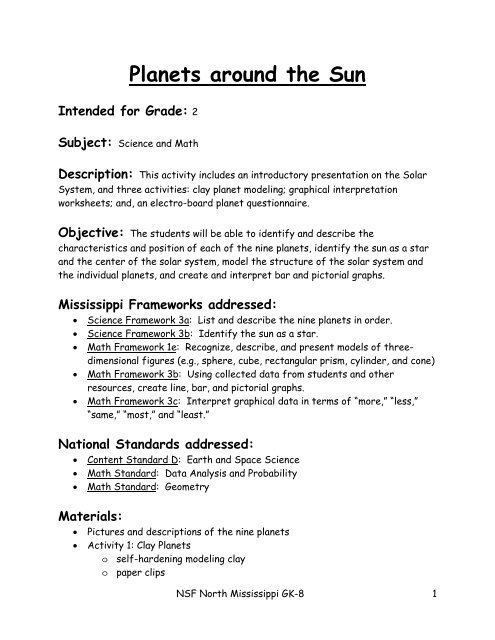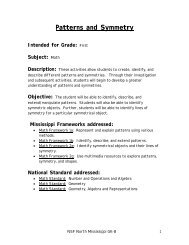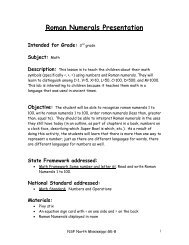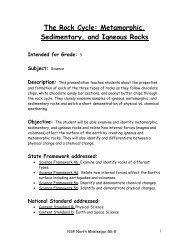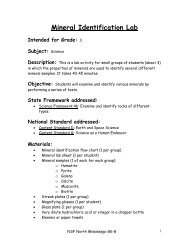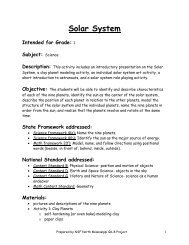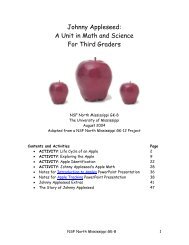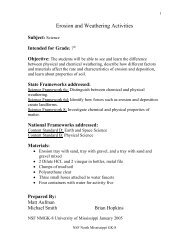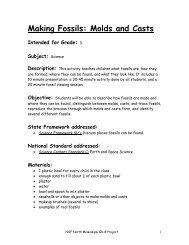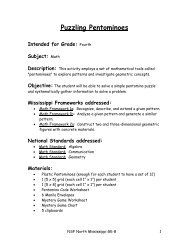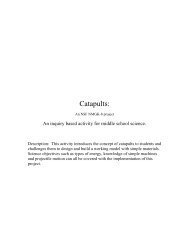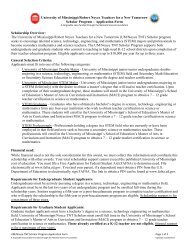Planets around the Sun - The Center for Mathematics and Science ...
Planets around the Sun - The Center for Mathematics and Science ...
Planets around the Sun - The Center for Mathematics and Science ...
Create successful ePaper yourself
Turn your PDF publications into a flip-book with our unique Google optimized e-Paper software.
Intended <strong>for</strong> Grade: 2<strong>Planets</strong> <strong>around</strong> <strong>the</strong> <strong>Sun</strong>Subject: <strong>Science</strong> <strong>and</strong> MathDescription: This activity includes an introductory presentation on <strong>the</strong> SolarSystem, <strong>and</strong> three activities: clay planet modeling; graphical interpretationworksheets; <strong>and</strong>, an electro-board planet questionnaire.Objective: <strong>The</strong> students will be able to identify <strong>and</strong> describe <strong>the</strong>characteristics <strong>and</strong> position of each of <strong>the</strong> nine planets, identify <strong>the</strong> sun as a star<strong>and</strong> <strong>the</strong> center of <strong>the</strong> solar system, model <strong>the</strong> structure of <strong>the</strong> solar system <strong>and</strong><strong>the</strong> individual planets, <strong>and</strong> create <strong>and</strong> interpret bar <strong>and</strong> pictorial graphs.Mississippi Frameworks addressed:• <strong>Science</strong> Framework 3a: List <strong>and</strong> describe <strong>the</strong> nine planets in order.• <strong>Science</strong> Framework 3b: Identify <strong>the</strong> sun as a star.• Math Framework 1e: Recognize, describe, <strong>and</strong> present models of threedimensionalfigures (e.g., sphere, cube, rectangular prism, cylinder, <strong>and</strong> cone)• Math Framework 3b: Using collected data from students <strong>and</strong> o<strong>the</strong>rresources, create line, bar, <strong>and</strong> pictorial graphs.• Math Framework 3c: Interpret graphical data in terms of “more,” “less,”“same,” “most,” <strong>and</strong> “least.”National St<strong>and</strong>ards addressed:• Content St<strong>and</strong>ard D: Earth <strong>and</strong> Space <strong>Science</strong>• Math St<strong>and</strong>ard: Data Analysis <strong>and</strong> Probability• Math St<strong>and</strong>ard: GeometryMaterials:• Pictures <strong>and</strong> descriptions of <strong>the</strong> nine planets• Activity 1: Clay <strong>Planets</strong>o self-hardening modeling clayo paper clipsNSF North Mississippi GK-8 1
o stringo markers or tempera paint• Activity 2: Graphing Worksheetso Crayons or markerso Scissorso Glue sticko Moon cutoutso Provided graphing worksheets (2)• Activity 3: Electro-boardo Electro-board (instructions included – see pages 29-33)o Continuity tester (<strong>the</strong> “light up” pen)****NOTE: Continuity testers are often very sharp! Please file <strong>the</strong>m down ifpossible <strong>and</strong> instruct <strong>the</strong> students to exercise caution when using <strong>the</strong>m.Background: <strong>The</strong> scientists that study <strong>the</strong> solar system are calledastronomers. <strong>The</strong>y study <strong>the</strong> universe, including <strong>the</strong> sun, moon, planets, stars, <strong>and</strong>galaxies. <strong>The</strong>y also apply <strong>the</strong>ir knowledge to solve problems in navigation, spaceflight, <strong>and</strong> satellite communications, <strong>and</strong> to develop <strong>the</strong> instrumentation <strong>and</strong>techniques used to observe <strong>and</strong> collect astronomical data. Astronauts are <strong>the</strong>scientists that actually fly into outer space. During <strong>the</strong>ir space missions, <strong>the</strong>y use<strong>the</strong> instruments <strong>and</strong> techniques designed by <strong>the</strong> astronomers to collect in<strong>for</strong>mationabout our solar system.Our SOLAR SYSTEM is made up of one star (<strong>the</strong> <strong>Sun</strong>), nine planets, more than 130moons, <strong>and</strong> a bunch of comets, asteroids <strong>and</strong> o<strong>the</strong>r space rocks. In order from <strong>the</strong>sun, <strong>the</strong> nine planets are Mercury, Venus, Earth, Mars, Jupiter, Saturn, Uranus,Neptune <strong>and</strong> Pluto. Mercury is closest to our <strong>Sun</strong>. Pluto is <strong>the</strong> far<strong>the</strong>st. <strong>The</strong> orderof <strong>the</strong> planets can be remembered like this: My Very Educated Mo<strong>the</strong>r JustServed Us Nine Pizzas.<strong>Planets</strong>, asteroids <strong>and</strong> comets revolve <strong>around</strong> <strong>the</strong> <strong>Sun</strong>. <strong>The</strong>y travel <strong>around</strong> our <strong>Sun</strong>in a flattened circle called an ellipse. It takes <strong>the</strong> Earth one year to go completely<strong>around</strong> <strong>the</strong> <strong>Sun</strong>, or one year to complete a revolution. Mercury goes <strong>around</strong> <strong>the</strong> <strong>Sun</strong>in only 88 days. It takes Pluto 248 years to make one trip <strong>around</strong> <strong>the</strong> <strong>Sun</strong>.As <strong>the</strong> earth revolves <strong>around</strong> <strong>the</strong> sun, it also rotates <strong>around</strong> its own axis. <strong>The</strong>earth completes one rotation per day. This rotation is why we experience day <strong>and</strong>night- during part of <strong>the</strong> rotation, our portion of <strong>the</strong> earth is facing away from <strong>the</strong>sun, so it is dark outside! <strong>The</strong> earth completes 365 rotations over <strong>the</strong> course ofone revolution.NSF North Mississippi GK-8 2
Moons orbit planets. Right now, Jupiter has <strong>the</strong> most moons—58. Mercury <strong>and</strong>Venus don't have any moons. Earth has one. It is <strong>the</strong> brightest object in our nightsky. <strong>The</strong> <strong>Sun</strong>, of course, is <strong>the</strong> brightest object in our daytime sky. It lights up <strong>the</strong>moon, planets, comets <strong>and</strong> asteroids, too. Without our <strong>Sun</strong>, <strong>the</strong>re would be no lifeon Earth.<strong>The</strong> SUN is <strong>the</strong> biggest, brightest <strong>and</strong> hottest object in our solar system. It is ourclosest star, <strong>and</strong> <strong>the</strong> only star in our solar system. <strong>The</strong> <strong>Sun</strong> is way too hot to visit.A person or spacecraft couldn't even get near it. Even if you could get close, <strong>the</strong>sun’s powerful gravity would make one of your arms weigh as much as your wholebody. It would be impossible to move!Our <strong>Sun</strong> is a ball of hot, glowing gases. <strong>The</strong> part we can see is about 11,000°F(6,100°C) <strong>and</strong> it gets even hotter as you go deeper. <strong>The</strong> oven in your kitchen onlygets as high as 500°F (260°C). <strong>The</strong> surface of <strong>the</strong> <strong>Sun</strong> boils like a pot of soup! Italso shoots flares of hot gas thous<strong>and</strong>s of miles into space. All of <strong>the</strong> heat <strong>and</strong>light from <strong>the</strong> sun provides us with plenty of energy!MERCURY is <strong>the</strong> closest planet to our <strong>Sun</strong> <strong>and</strong> is <strong>the</strong> second smallest planet in oursolar system. If Earth were <strong>the</strong> size of a baseball, Mercury would be <strong>the</strong> size of agolf ball. It zips <strong>around</strong> <strong>the</strong> <strong>Sun</strong> every 88 days – faster than any o<strong>the</strong>r planet. (Ino<strong>the</strong>r words, it takes Earth 365 days to make one revolution, but it only takesMercury 88 days to make one revolution!)Since Mercury is so close to <strong>the</strong> sun, it is very hot. <strong>The</strong> temperature on Mercurycan change more than 1,000°F (530°C) between night <strong>and</strong> day. <strong>The</strong>re is very littleair, or atmosphere, to hold in <strong>the</strong> heat when <strong>the</strong> <strong>Sun</strong> is not shining. <strong>The</strong> thinatmosphere also means meteors don't burn up, so Mercury is covered with craters.It looks a lot like our moon.VENUS is <strong>the</strong> second planet from our <strong>Sun</strong>. It is Earth's closest neighbor – <strong>the</strong>second brightest object in our night sky. Only <strong>the</strong> moon is brighter. Even though itis so close to Earth, Venus is very mysterious. <strong>The</strong> surface is hidden beneath hot,poisonous air made up mostly of carbon dioxide. Scientists must use radar to 'see'through Venus' clouds. Venus has no moon <strong>and</strong> no rings. To get to <strong>the</strong> surface ofVenus, you would have to pass through clouds of sulfuric acid, hurricane-<strong>for</strong>cewinds, <strong>and</strong> lightning.<strong>The</strong> temperature on Venus can get up to almost 900°F (482°C). It gets hotter thanMercury because it has such a thick atmosphere. <strong>The</strong> air is thick <strong>and</strong> poisonous.NSF North Mississippi GK-8 3
Venus' atmosphere is so heavy that it would feel like you were deep in <strong>the</strong> ocean.Remember how your head feels squeezed at <strong>the</strong> bottom of a swimming pool? Thatis pressure. On Venus, <strong>the</strong> pressure is so strong it would crush you. In fact, metalspacecrafts were smashed after only a few hours on <strong>the</strong> surface of Venus.Because <strong>the</strong> planet rotates so sluggishly, a day on Venus lasts longer than it takesto go <strong>around</strong> <strong>the</strong> <strong>Sun</strong>. Imagine if we switched to Venusians clocks on Earth. Aschool day would last four months! Ugh.EARTH: In some ways, Earth is similar to Mercury, Venus, <strong>and</strong> Mars. <strong>The</strong>y are allhard, rocky planets. All four have meteor impact craters. Like Mars <strong>and</strong> Venus,Earth has volcanoes, mountains <strong>and</strong> valleys.But Earth is different in very important ways. Most of our planet is covered withwater. <strong>The</strong> air is made of nitrogen, oxygen, <strong>and</strong> a little carbon dioxide - just right<strong>for</strong> us to brea<strong>the</strong>. Earth is home to people, plants, <strong>and</strong> animals because it has bothwater <strong>and</strong> <strong>the</strong> right kind of atmosphere.Earth has one moon. It is <strong>the</strong> brightest <strong>and</strong> most familiar object in <strong>the</strong> night sky.In many ways, <strong>the</strong> moon is responsible <strong>for</strong> making Earth such a great home. Itstabilizes our planet's wobble, which makes <strong>the</strong> wea<strong>the</strong>r nicer!<strong>The</strong> MOON is covered with craters. Because it has no atmosphere to protect it,space rocks – some as big as mountains – have smashed into it. <strong>The</strong> moon's surfaceis rocky <strong>and</strong> covered with dust.<strong>The</strong> moon's weak gravity means it is easy <strong>for</strong> people to move <strong>around</strong> when <strong>the</strong>y areon <strong>the</strong> moon, even in a heavy spacesuit. It is impossible <strong>for</strong> people to explore <strong>the</strong>Moon without a spacesuit because <strong>the</strong>re is no air, <strong>and</strong> <strong>the</strong> radiation from <strong>the</strong> <strong>Sun</strong> isvery dangerous. It gets very hot <strong>and</strong> very cold on <strong>the</strong> moon.MARS is <strong>the</strong> fourth planet from <strong>the</strong> <strong>Sun</strong>. It is sometimes called <strong>the</strong> 'Red Planet'because of its red soil. <strong>The</strong> soil on Mars is red because it contains iron oxide (rust).Mars is one of <strong>the</strong> brightest objects in <strong>the</strong> night sky. It has two moons, Phobos <strong>and</strong>Deimos. <strong>The</strong> thin air on Mars makes it a dangerous place <strong>for</strong> humans. It is mostlypoisonous carbon dioxide. You would need a spacesuit to visit Mars too. Mars is arocky, dusty, dry planet. <strong>The</strong> sky would be hazy <strong>and</strong> red instead of blue like it ishere on earth. Sometimes giant dust storms cover <strong>the</strong> whole planet!NSF North Mississippi GK-8 4
JUPITER is <strong>the</strong> fifth planet from our <strong>Sun</strong>. It is <strong>the</strong> biggest planet in our solarsystem. All of <strong>the</strong> o<strong>the</strong>r planets could fit inside of Jupiter! Jupiter would not be anice place to visit because it is just a giant ball of gas. Any spacecraft - or person -passing through <strong>the</strong> colorful clouds would be crushed <strong>and</strong> melted. On Jupiter, <strong>the</strong>pressure is so strong that it squishes gas into liquid. Jupiter's atmosphere cancrush a metal spaceship like a paper cup.Jupiter's stripes <strong>and</strong> swirls are cold, windy clouds of ammonia <strong>and</strong> water. Its GreatRed Spot is a giant storm as wide as three Earths. This storm has lasted hundredsof years. Jupiter's atmosphere is poisonous, composed mostly of hydrogen <strong>and</strong>helium. <strong>The</strong>re is also dangerous radiation, <strong>and</strong> it gets very hot <strong>and</strong> very cold. Talkabout bad wea<strong>the</strong>r!Jupiter has its own 'mini solar system' of 61 moons <strong>and</strong> three rings, but <strong>the</strong>y arevery hard to see.SATURN is <strong>the</strong> sixth planet from our <strong>Sun</strong> <strong>and</strong> is <strong>the</strong> second largest planet in <strong>the</strong>solar system. Saturn has <strong>the</strong> most spectacular rings of any planet in <strong>the</strong> solarsystem. It is often called <strong>the</strong> “jewel of <strong>the</strong> solar system” because of its beautifulrings. <strong>The</strong>y are made of billions of small chunks of ice <strong>and</strong> rock. <strong>The</strong> chunks can beas small as a grain of sugar or as big as a house.Saturn is a lot like Jupiter. It is made up mostly of gas, including hydrogen, helium<strong>and</strong> methane. It doesn't have a solid surface. Saturn has clouds, stripes, <strong>and</strong>storms like Jupiter, but <strong>the</strong>y are harder to see. <strong>The</strong> clouds we see are mostlyyellow <strong>and</strong> white. A person dropping through <strong>the</strong> icy clouds would be crushed by <strong>the</strong>pressure, which is so powerful it squeezes gas into liquid. Even a metal spacecraftwould be smashed! Saturn has at least 31 moons.URANUS is <strong>the</strong> seventh planet from our <strong>Sun</strong>. It is <strong>the</strong> third largest planet in oursolar system. Uranus is very cold, windy <strong>and</strong>, like most of <strong>the</strong> o<strong>the</strong>r planets,poisonous to humans. It is a gas planet like Jupiter, Saturn, <strong>and</strong> Neptune. A personor spacecraft diving through Uranus' clouds would be crushed by <strong>the</strong> pressure.Seasons on Uranus last more than 20 years because <strong>the</strong> planet is tilted on its side.Methane gas present on Uranus absorbs red light <strong>and</strong> reflects <strong>the</strong> blue-greencolors we see when we look at Uranus through a telescope. Uranus is so far away itis difficult to study. Uranus' 11 rings weren't discovered until 1977 <strong>and</strong> several ofNSF North Mississippi GK-8 5
Uranus' 27 known moons were discovered as recently as 2003. <strong>The</strong>re may be moreundiscovered moons out <strong>the</strong>re!NEPTUNE: Most of <strong>the</strong> time Neptune is <strong>the</strong> eighth planet from our <strong>Sun</strong>.Sometimes Pluto's odd orbit brings it closer to <strong>the</strong> <strong>Sun</strong>. For <strong>the</strong> next 230 years orso, all you have to remember is that Neptune is <strong>the</strong> eighth planet. It takes a longtime <strong>for</strong> <strong>the</strong>se distant planets to travel <strong>around</strong> <strong>the</strong> sun.Neptune is <strong>the</strong> fourth largest planet in our solar system. About 60 Earths could fitinside it. Neptune may be <strong>the</strong> windiest planet in <strong>the</strong> solar system. Winds tearthrough <strong>the</strong> clouds at more than 1,200 mph (2,000 kph).Neptune gets its blue color from a layer of methane gas above <strong>the</strong> clouds. Methaneabsorbs red light so only blue colors show up when we look at Neptune. Neptune hasfour rings <strong>and</strong> 13 known moons. Neptune's largest moon, Triton, gets colder thanPluto.PLUTO: Pluto <strong>and</strong> its moon – Charon – travel on an odd, slow orbit <strong>around</strong> <strong>the</strong> <strong>Sun</strong>.For 20 years, from 1979 to 1999, it was actually closer to <strong>the</strong> <strong>Sun</strong> than Neptune,but it will be more than 230 years be<strong>for</strong>e Pluto <strong>and</strong> Neptune trade places again.<strong>The</strong>re is no air to brea<strong>the</strong> on Pluto, so you would need a spacesuit to explore it.Pluto <strong>and</strong> Charon are so far away <strong>the</strong>y are difficult to see - even with powerfultelescopes. Even <strong>the</strong> best pictures are very fuzzy. We can only guess what Pluto'ssurface looks like. It is probably covered with frost. Some areas may be brighterthan snow, while o<strong>the</strong>rs are very dark.COMETS orbit <strong>the</strong> <strong>Sun</strong> like planets. Most comets orbit way out beyond <strong>the</strong> orbit ofPluto. It can take a comet hundreds or even millions of years to go once <strong>around</strong> <strong>the</strong><strong>Sun</strong> (remember, on Earth it only takes 365 days). A few comets are close enough<strong>for</strong> us to see from Earth. When Earth passes through <strong>the</strong> tail of a comet, we see ameteor shower.ASTEROIDS are <strong>the</strong> biggest space rocks. Asteroids are made up of rock <strong>and</strong> iron,just like <strong>the</strong> four planets closest to our <strong>Sun</strong>. <strong>The</strong>y are different from comets,which are mostly rock <strong>and</strong> ice <strong>and</strong> have tails. Asteroids are more like planets <strong>and</strong>moons. Scientists often call asteroids minor planets. Most asteroids orbit <strong>the</strong> <strong>Sun</strong>NSF North Mississippi GK-8 6
etween Mars <strong>and</strong> Jupiter. This area is called <strong>the</strong> asteroid belt. <strong>The</strong>re are millionsof asteroids.As <strong>the</strong>y bang <strong>around</strong> out <strong>the</strong>re in space, <strong>the</strong>se rocks break into smaller <strong>and</strong> smallerpieces that sometimes fall to Earth. Most of <strong>the</strong>m burn up in streaks of light.Some asteroids crash into our planet <strong>and</strong> leave behind meteorites. Sometimes areally big asteroid will leave a giant crater.METEROIDS: Smaller pieces of rock <strong>and</strong> iron that travel through space are calledmeteoroids. Meteoroids orbit our <strong>Sun</strong> just like asteroids <strong>and</strong> planets.When a space rock enters Earth's atmosphere, it becomes a meteor - or shootingstar. <strong>The</strong> meteor heats up <strong>and</strong> makes <strong>the</strong> air <strong>around</strong> it glow, allowing us to see astreak of light. Most meteors burn up be<strong>for</strong>e <strong>the</strong>y make it to <strong>the</strong> ground on earth.Scientists think up to 10,000 tons of meteors fall on <strong>the</strong> Earth each day, but mostare no bigger than a speck of dust.A meteor makes it all <strong>the</strong> way to ground without burning up in <strong>the</strong> atmosphere iscalled a meteorite. Meteorites range in size from tiny pebbles to boulders.Some planets <strong>and</strong> moons don't have enough atmosphere to protect <strong>the</strong>m againstmeteor <strong>and</strong> asteroid impacts. Earth's moon, Mercury, <strong>and</strong> even Mars are coveredwith round impact craters from <strong>the</strong>se collisions.Procedure:1. Hang 10 pieces of string from <strong>the</strong> ceiling of your classroom to resemble <strong>the</strong>Solar System (a piece <strong>for</strong> <strong>the</strong> <strong>Sun</strong> in <strong>the</strong> middle <strong>and</strong> nine o<strong>the</strong>r pieces atvarious distances from <strong>the</strong> center surrounding <strong>the</strong> <strong>Sun</strong>).2. Discuss each of <strong>the</strong> planets, <strong>the</strong> sun, <strong>and</strong> <strong>the</strong> solar system with <strong>the</strong> students(while showing <strong>the</strong> picture cards).3. Split <strong>the</strong> class in half (into teams of 10- 12 students). Half of <strong>the</strong> class willmold planets out of clay (Activity 1) <strong>and</strong> <strong>the</strong> o<strong>the</strong>r half will take turns using<strong>the</strong> Electro-boards (Activity 3) <strong>and</strong> completing <strong>the</strong>ir graphing worksheets(Activity 2) when it is not <strong>the</strong>ir turn. <strong>The</strong>n <strong>the</strong>y will switch.4. NOTE: <strong>The</strong>se activities can all be done on <strong>the</strong> same day or <strong>the</strong>y can bespread out over several days.5. Activity 1: Clay <strong>Planets</strong>NSF North Mississippi GK-8 7
a. Assign each student one of <strong>the</strong> planets or <strong>the</strong> sun (or a comet orasteroid if <strong>the</strong>re are more than 10 students in each group).b. Hang <strong>the</strong> pictures of <strong>the</strong> planets somewhere in <strong>the</strong> room where allstudents can see <strong>the</strong>m.c. Distribute enough clay to each student to model his or her planetroughly to scale.d. Have students model <strong>the</strong>ir planet with any characteristic properties.e. Place a paper clip in <strong>the</strong> top of <strong>the</strong> planet so it can be hung from <strong>the</strong>ceiling when it hardens.f. Allow planets to harden overnight or until completely dry (note that<strong>the</strong> drying process may take several days but it is important that <strong>the</strong>clay hardens completely in order <strong>for</strong> <strong>the</strong> paper clips to hold).g. **At this point <strong>the</strong> students can switch to Activity 2. <strong>The</strong> remainderof this activity has to be finished ano<strong>the</strong>r day, after <strong>the</strong> planets havedried.h. Have students realistically paint or color <strong>the</strong>ir planet with markers.i. Have students come up one at a time <strong>and</strong> hang <strong>the</strong>ir planet in orderfrom <strong>the</strong> sun. Do not point out who should come up next. Start with<strong>the</strong> sun <strong>and</strong> <strong>the</strong>n ask which planet comes next. Have that studentcome <strong>and</strong> hang <strong>the</strong>ir planet up. Continue until both classroom sets of<strong>the</strong> solar system are hanging.6. Activity 2: Graphing Worksheetsa. Pass out data <strong>and</strong> charts to each student (each student should have 2charts, a list of questions, <strong>and</strong> <strong>the</strong> moons picture page).b. Have <strong>the</strong> students cut out all of <strong>the</strong> moons.c. Instruct students to complete both graphs <strong>and</strong> answer <strong>the</strong> questionsas <strong>the</strong> directions indicate.7. Activity 3: Planet Description Electro-Boarda. Whenever students are not working on <strong>the</strong>ir graphs let each try <strong>the</strong>electro-board (or <strong>the</strong>y can work in teams of 2).b. Using <strong>the</strong> continuity tester, touch <strong>the</strong> “alligator clip” end to <strong>the</strong> bradnext to a question on <strong>the</strong> board. <strong>The</strong>n touch <strong>the</strong> “pen” end to <strong>the</strong> bradnext to <strong>the</strong> correct answer. If <strong>the</strong> question is answered correctly,<strong>the</strong> tester will light up. If <strong>the</strong> question is answered incorrectly, <strong>the</strong>tester will not light.c. <strong>The</strong> student should keep going until every question is answeredcorrectly.NSF North Mississippi GK-8 8
Evaluation: Students’ individual planet models will demonstrate <strong>the</strong>irunderst<strong>and</strong>ing of <strong>the</strong> relative size of each planet <strong>and</strong> <strong>the</strong> order <strong>and</strong> distance from<strong>the</strong> sun. <strong>The</strong> graphing worksheets can be used to asses <strong>the</strong>ir underst<strong>and</strong>ing of howto create bar <strong>and</strong> pictorial graphs. <strong>The</strong> questions can be used to determine <strong>the</strong>students’ ability to interpret bar <strong>and</strong> pictorial graphs. Although <strong>the</strong> electro-boardis self corrective, <strong>the</strong> frequency with which <strong>the</strong> tester lights up will indicate <strong>the</strong>level of underst<strong>and</strong>ing <strong>the</strong> student has regarding planet descriptions.Extended Activities:Which Planet Am I?Materials:• writing processor- (Student Writing <strong>Center</strong>, Word, Works, or any o<strong>the</strong>rwriting program)• graphic program - (KidPix, Draw, or any o<strong>the</strong>r drawing/graphics program)or drawing paper, crayons, colored pencils.• books, videos, magazines, <strong>and</strong> appropriate web sites that can be used <strong>for</strong>resources.• list of internet resources that may be helpful <strong>for</strong> this project. A few goodwebsites are:o Amazing Space - http://amazing-space.stsci.edu/Find out about <strong>the</strong> night sky. Includes great pictures <strong>and</strong> in<strong>for</strong>mation on<strong>the</strong> solar system. Read <strong>the</strong> about <strong>the</strong> history of astronomy from Galileoto <strong>the</strong> Hubble Space Telescope.o Cassini Mission: Kid's Corner - http://saturn.jpl.nasa.gov/kids/index.cfmLearn more about Saturn <strong>and</strong> its mysterious rings.o Planetary Fact Sheets - http://nssdc.gsfc.nasa.gov/planetary/planetfact.htmlA list of links to fact sheets on <strong>the</strong> planets of <strong>the</strong> solar system.o Sea <strong>and</strong> Sky: <strong>The</strong> Sky - http://www.seasky.org/sky.htmlTake a tour of <strong>the</strong> sky gallery, <strong>the</strong> solar system, <strong>and</strong> sky lab. Lots to see<strong>and</strong> do at this site.o StarChild : A Learning <strong>Center</strong> <strong>for</strong> Young Astronomers -http://heasarc.gsfc.nasa.gov/docs/StarChild/ This site will give in<strong>for</strong>mation on<strong>the</strong> solar system, <strong>and</strong> space exploration <strong>for</strong> primary age students.NSF North Mississippi GK-8 9
o Windows to <strong>the</strong> Universe - http://www.windows.umich.edu/Fun <strong>and</strong> interesting site about <strong>the</strong> planets, solar system , <strong>the</strong> universe,space missions, <strong>and</strong> news.Activity Description:1. Students will select a planet to research. <strong>The</strong>y will use Internet resources,books, magazines, <strong>and</strong> videos to find facts about <strong>the</strong>ir planet.2. <strong>The</strong> student will write <strong>the</strong>ir in<strong>for</strong>mation about <strong>the</strong>ir planet in <strong>the</strong> <strong>for</strong>m of ariddle.Example:I am <strong>the</strong> red planet. I have ice caps at my north <strong>and</strong> south poles. Somescientists think <strong>the</strong>re might have been water on my surface. I have twomoons named Phobos <strong>and</strong> Deimos. I have had space probes l<strong>and</strong> on mysurface <strong>and</strong> <strong>the</strong>y have taken soil samples. I have volcanoes <strong>and</strong> canals on mysurface. I am <strong>the</strong> fourth planet from <strong>the</strong> sun. I am 30 million miles fromEarth. It would take astronauts 11 months to get to me. Which planet am I?3. <strong>The</strong>y would be encouraged to put many interesting facts about <strong>the</strong>ir planetin <strong>the</strong> written product.4. Students would <strong>the</strong>n draw <strong>and</strong> color a picture of <strong>the</strong>ir planet. <strong>The</strong>y could useei<strong>the</strong>r paper <strong>and</strong> crayons or <strong>the</strong> computer paint programs that might beavailable to <strong>the</strong>m.5. This could be made into a classroom book <strong>for</strong> all to read <strong>and</strong> enjoy.Evaluation:Students would be evaluated on <strong>the</strong>ir composition skills, <strong>the</strong> accuracy of <strong>the</strong>scientific in<strong>for</strong>mation presented, ef<strong>for</strong>t put into artwork, <strong>and</strong> <strong>the</strong> research skillsof <strong>the</strong> students.Sources:http://atozteacherstuff.com/go/jump2.cgi?ID=2906http://sse.jpl.nasa.gov/planets/index.cfmhttp://www.dustbunny.com/afk/planets/pluto/Extended Activity was taken from:http://www.siec.k12.in.us/~west/proj/space/lesson1.htmNSF North Mississippi GK-8 10
Dunn, Rita <strong>and</strong> Dunn, Kenneth. 1993. Teaching Secondary Students Through <strong>The</strong>irIndividual Learning Styles: Practical Approaches <strong>for</strong> grades 7-12. NeedhamHeitghts, MA: Allyn &Bacon. 172-173.Prepared by:Emlee WoodardAshley PhillipsAlice San<strong>for</strong>dNSF NMGK8University of MississippiJune 2004NSF North Mississippi GK-8 11
<strong>The</strong> <strong>Sun</strong><strong>The</strong> <strong>Sun</strong> is <strong>the</strong> biggest, brightest <strong>and</strong>hottest object in our Solar System.<strong>The</strong> <strong>Sun</strong> is our closest star <strong>and</strong> <strong>the</strong>only star in our solar system!!NSF North Mississippi GK-8 12
MercuryMercury is <strong>the</strong> closest planet to <strong>the</strong><strong>Sun</strong> so it is very hot. Mercury is <strong>the</strong>second smallest planet in our solarsystem. <strong>The</strong> surface of Mercury isgray to orange in color. Mercury iscovered with craters!!NSF North Mississippi GK-8 13
VenusVenus is <strong>the</strong> second planet away from<strong>the</strong> sun. Venus is Earth’s closestneighbor. Venus is a brownish-yellowcolor. Venus is <strong>the</strong> hottest planet inour solar system!NSF North Mississippi GK-8 14
EarthEarth is <strong>the</strong> planet we live on!Earth is different from all o<strong>the</strong>rplanets because it has liquid wateron its surface <strong>and</strong> people live on it!!NSF North Mississippi GK-8 15
MarsMars is <strong>the</strong> 4 th planet from <strong>the</strong> sun.It is also Earth’s neighbor. Itssurface is very cold <strong>and</strong> is coveredwith craters, volcanoes, <strong>and</strong> largecanyons. Mars is reddish in color<strong>and</strong> sometimes called <strong>the</strong> “RedPlanet.”NSF North Mississippi GK-8 16
JupiterJupiter is <strong>the</strong> largest planet inour Solar System. All of <strong>the</strong>o<strong>the</strong>r planets could fit inside ofJupiter! Jupiter is broken intob<strong>and</strong>s of white, yellow, red, <strong>and</strong>brown clouds.NSF North Mississippi GK-8 17
SaturnSaturn is well known <strong>for</strong> itssystem of three rings. <strong>The</strong>surface of Saturn looks b<strong>and</strong>ed<strong>and</strong> has a butterscotch color.<strong>The</strong> rings <strong>around</strong> Saturn arecomposed of rock <strong>and</strong> ice.NSF North Mississippi GK-8 18
UranusUranus is covered by a thicklayer of gas <strong>and</strong> is a blue-greencolor. Uranus is very cold <strong>and</strong>windy. It is <strong>the</strong> seventh planetfrom <strong>the</strong> sun.NSF North Mississippi GK-8 19
NeptuneNeptune is slightly smallerthan Uranus. It looks blue <strong>and</strong>has large dark blue stormclouds. Like Uranus, Neptuneis cold <strong>and</strong> very windy.NSF North Mississippi GK-8 20
PlutoPluto is <strong>the</strong> most distant planetfrom <strong>the</strong> <strong>Sun</strong>. Pluto is also <strong>the</strong>smallest planet. Its surface <strong>and</strong>color are basically unknownbecause it is so far away!!!NSF North Mississippi GK-8 21
<strong>The</strong> Solar SystemOur Solar System is composed of<strong>the</strong> <strong>Sun</strong>, <strong>the</strong> nine planets, <strong>and</strong> manysmall objects like comets <strong>and</strong>asteroids. All of <strong>the</strong> planetsrevolve <strong>around</strong> <strong>the</strong> <strong>Sun</strong>. <strong>The</strong> nineplanets in order from <strong>the</strong> <strong>Sun</strong> are:NSF North Mississippi GK-8 22
Our Solar System:<strong>Sun</strong>, Mercury, Venus, Earth, Mars, Jupiter, Saturn, Uranus, Neptune, <strong>and</strong>Pluto. Notice <strong>the</strong> relative sizes of <strong>the</strong> planets <strong>and</strong> <strong>the</strong> <strong>Sun</strong>.http://www.jpl.nasa.gov/galileo/sepo/education/nav/ss2.gifNSF North Mississippi GK-8 23
Using <strong>the</strong> following data, make a pictorial graph by gluing <strong>the</strong> moonsbelow in <strong>the</strong> correct place on <strong>the</strong> “Moons of <strong>the</strong> <strong>Planets</strong> PictorialGraph.”<strong>Planets</strong>Number of MoonsMercury 0Venus 0Earth 1Mars 2Jupiter 16Saturn 18Uranus 20Neptune 8Pluto 1Color <strong>and</strong> cut out <strong>the</strong> moons on <strong>the</strong> next page <strong>and</strong> <strong>the</strong>n glue <strong>the</strong>m in astack on your “Moons of <strong>the</strong> <strong>Planets</strong> Pictorial Graph” until <strong>the</strong>y reach<strong>the</strong> correct number of moons <strong>for</strong> each planet.Note: 1 moon picture represents 2 planet moons. So <strong>for</strong> <strong>the</strong>planets with only one moon, you may want to cut <strong>the</strong> moon in half.NSF North Mississippi GK-8 24
Directions: Cut along <strong>the</strong> solid lines.NSF North Mississippi GK-8 25
Name:_______________________________20Moons of <strong>the</strong> <strong>Planets</strong> Pictorial Graph181614Number of Moons12108642MercuryVenusEarthMarsJupiterSaturnUranusNeptunePluto0<strong>Planets</strong>NSF North Mississippi GK-8 26
Name:_______________________Using <strong>the</strong> following data, draw <strong>and</strong> color a bar graph on <strong>the</strong> chart below.<strong>Planets</strong> Temperature (°Farenheight)Mercury 452Venus 726Earth 285Mars 230Jupiter 120Saturn 88Uranus 59Neptune 48Pluto 37800Temperature on <strong>the</strong> <strong>Planets</strong> Bar Graph7006005004003002001000MercuryVenusEarthMarsJupiterSaturnUranusTemperature (°F)NeptunePluto<strong>Planets</strong>NSF North Mississippi GK-8 27
Name: _________________________Use <strong>the</strong> two graphs you created to answer <strong>the</strong> following questions.Temperature:1. Which planet is <strong>the</strong> hottest?2. Which planet is <strong>the</strong> coldest?3. Which planet is hotter than Jupiter <strong>and</strong> colder than Earth?4. Which two planets have <strong>the</strong> closest temperature to Neptune’s?Moons:1. List all pairs of planets which have <strong>the</strong> same number of moons.2. Which planet has <strong>the</strong> most moons?3. Which planets have more moons than Neptune?4. Which planet has fewer moons than Saturn but more thanNeptune?NSF North Mississippi GK-8 28
An electro-board can be a useful learning tool in virtually any discipline.Instructions to Build <strong>and</strong> Electro-board:1. Write several questions about <strong>the</strong> planet’s characteristics <strong>and</strong> <strong>the</strong>answers to those questions <strong>and</strong> cut <strong>the</strong>m out. If you have selfadherent paper of some kind (mailing labels work well), you may wantto write or print on that.2. Obtain a piece of poster board, a pocket folder (without metalfasteners), or any heavy weight paper.3. Punch holes down <strong>the</strong> left h<strong>and</strong> side that are approximatelyequidistant. You will need <strong>the</strong> same number of holes as questions youwish to ask.NSF North Mississippi GK-8 29
4. Punch holes down <strong>the</strong> right h<strong>and</strong> side as level as possible with <strong>the</strong>holes on <strong>the</strong> left h<strong>and</strong> side.5. Adhere <strong>the</strong> questions to <strong>the</strong> right of <strong>the</strong> holes on <strong>the</strong> left h<strong>and</strong> sideof <strong>the</strong> board using tape or glue if necessary.6. Stick <strong>the</strong> answers to <strong>the</strong> left of <strong>the</strong> holes on <strong>the</strong> board’s right sidein r<strong>and</strong>om order.*IMPORTANT: One question <strong>and</strong> answer pair need to be level withone ano<strong>the</strong>r.NSF North Mississippi GK-8 30
7. Turn <strong>the</strong> board over <strong>and</strong> connect <strong>the</strong> questions to <strong>the</strong> correctanswers using strips of tinfoil. Be sure to completely cover <strong>the</strong> holeswith <strong>the</strong> tinfoil.8. Using masking tape only, completely cover each strip of tinfoil.NSF North Mississippi GK-8 31
9. Take a metal fastener (or brad) <strong>and</strong> pierce <strong>the</strong> masking tape/tin foilin each hole from <strong>the</strong> front <strong>and</strong> fasten <strong>the</strong>m.10. Cover <strong>the</strong> back of <strong>the</strong> board with construction paper or anythingthat will hide <strong>the</strong> strips of tape. Remember to only use masking tape.11. Decorate <strong>the</strong> board using drawings or stickers following <strong>the</strong> <strong>the</strong>meof <strong>the</strong> questioning.NSF North Mississippi GK-8 32
12. Using <strong>the</strong> continuity tester, place <strong>the</strong> alligator clip on <strong>the</strong> brassfastener next to <strong>the</strong> question <strong>and</strong> <strong>the</strong> pen end on <strong>the</strong> answer. If <strong>the</strong>answer is correct, <strong>the</strong> pen will light up.13. Be sure to test each question be<strong>for</strong>e <strong>the</strong> students use <strong>the</strong> electroboard.NSF North Mississippi GK-8 33


